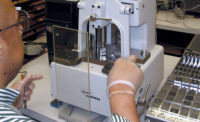
"Back in the day," as the saying goes, an experienced machinist would use a scratch pad and an educated fingernail to determine the surface quality of a part. Then, in the 1940s, E.J. Abbot of the University of Michigan developed a surface finish tester. Today, while scratch pads are still in occasional use, operators have a plethora of surface finish standards and parameters and a variety of gages to measure surfaces.
And as dimensional tolerances have grown tighter over the years and the need for documentation and traceability ever greater, the role of surface finish measurement in the manufacturing process has grown dramatically. In the 1940s the proportion of the tolerance band taken up by surface irregularities was roughly 15%. Today that proportion is frequently 50% or more.
For example, the maximum peak-to-valley height on a surface is usually four or five times greater than the average surface finish, as measured by the Ra method (average roughness). Therefore, a part with an Ra value of 16 microinches, probably has a peak-to-valley height of 64 microinches or greater. If trying to meet a dimensional spec of 0.0001 inch, the 16-microinch finish represents more than half the allowable tolerance.
So, when an engineer specifies surface finish on a print, the intent is usually not just to make the part look good. Surface finish affects how a part will fit, wear, reflect light, transmit heat, distribute lubrication and accept coatings. The nature of the finish should be determined by the part's function. You want a surface that fulfills the engineering requirements of the application, without wasting time and effort on a higher quality finish than is necessary. In fact, many applications do better with a certain amount of "texture." Too fine a finish can be as bad as too coarse.

Surface finish, sometimes called profile, is composed of two components: waviness and roughness. Waviness, or longer-wavelength variation, is caused by macro-type influences, such as worn spindle bearings or vibration from other equipment on the shop floor. Roughness is the short-wavelength pattern of tool marks from grinding, milling or other machining processes. Roughness is influenced by the condition and quality of the tooling. Both components can be influenced by the operator's choice of feed rate and depth of cut.

There are two basic varieties of surface finish gages: skid-type or averaging systems, and skidless or profiling systems. Skidded gages have a hinged probe assembly, with the probe riding next to a relatively broad skid that also contacts the workpiece. The skid tends to filter out waviness, so the probe measures only short-wavelength variations. A skidded gage usually has a dial or LCD readout to display the measurement as a single numerical value.
Skidless gages use a precision, internal surface as a reference, so the probe can respond to waviness as well as roughness. In order to allow separate analysis of long- and short-wavelength variations, skidless gages usually generate a chart, on paper or on a computer screen, rather than a single numerical result.
Every application reacts differently to different combinations of roughness and waviness, and industry has responded by creating more than 100 different formulae to calculate surface finish parameters from the same measurement data. Each of the parameters has its advantages and limitations, and many are very application specific. Often one parameter is incapable of adequately defining a surface, and two, three or even more parameters are required to complete the definition of a surface. In some cases, the relationship or ratio of one parameter to another is required. However, most shops are able to confine their measurements to a half-dozen parameters or so. In almost all cases, measurements are presented in microinch or micron units.
Ra is the most widely used parameter, because it provides an arithmetic average of surface irregularities measured from a mean line that lies somewhere between the highest and lowest points on a given cut-off length. Rq, a slightly more sophisticated variant, uses a root mean square calculation to find geometric average roughness-an averaged average, if you will. Both of these parameters, however, tend to minimize the influence of surface anomalies like burrs or scratches. To differentiate between "spiky" and "scratched" surfaces having the same Ra, additional parameters should be specified, such as Rp (maximum peak height), Rv (maximum valley depth) and Ry (maximum peak-to-valley roughness height).
If surface finish is called out on a drawing but not otherwise specified, it is standard practice to assume Ra. No single parameter is best for all types of parts, however, and many applications are best served by using two or more parameters. For example, Ra in combination with Rmax (maximum roughness) may provide a good general idea of the part's performance.
In Europe, the more common parameter for roughness is Rz, or mean roughness depth. It is the average distance between the highest peak and the deepest valley in five sampling lengths or cutoffs. Rz is more sensitive than Ra to the changes in surface finish, because maximum profile heights, and not the averages, are being examined. There is no firm conversion between Ra and Rz parameters, as the actual ratio depends upon the shape of the profile, but the approximate ratio of Rz = 4 x Ra can be used.
Maintaining good control over surface finish is not just a challenge, but an opportunity. In some cases, good surface control may allow you to safely reduce precision in other areas. Surface finish measurement procedures, general terminology, definitions of most parameters and filtering information can be found in American Standard ASME B46.1 - 2002, Surface Texture; and in International Standards, ISO 4287, ISO 4288.
